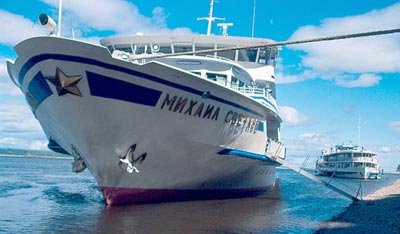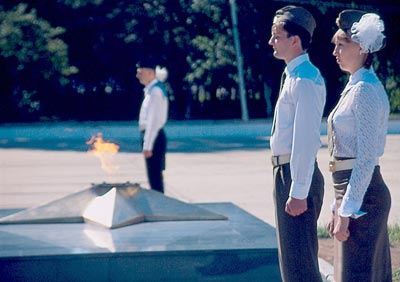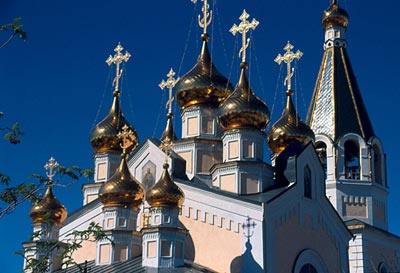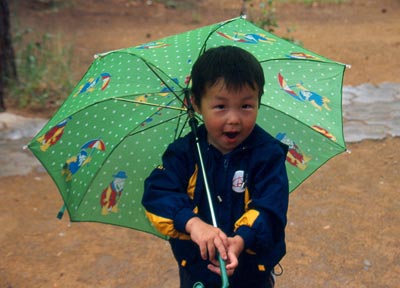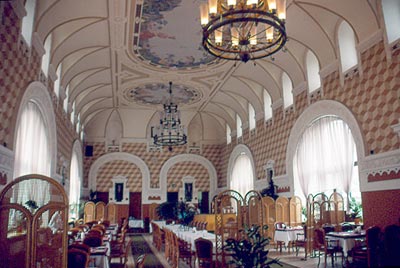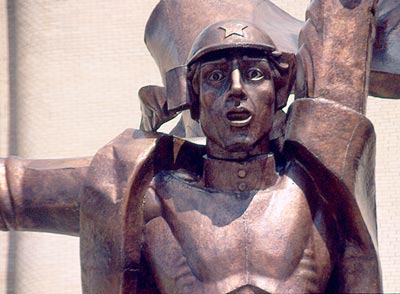From Vladivostok to Sakhalin Island — rediscovering the Russian Far East
by Bill Altaffer, Mammoth Lakes, CA
After an overnight in Seoul, South Korea, one of the most populated cities in the world today, our MIR Corp. tour group flew to Vladivostok, our entry and exit city for the Russian Far East.
First stop, Vladivostok
Between the end of World War II and the collapse of the Soviet Union at the end of 1991, Vladivostok was off-limits to foreigners and most Russians. Today it is a sister city to San Diego and is a lucrative base for international commerce due to its deep harbor, averaging 295 ice-free days a year.
Our base in Vladivostok was the 4-star Hotel Hyundai, located in the town center close to the seaport, theaters, a historical museum and a philharmonic hall.
During our day and a half in Vladivostok we explored some of its sights. After stopping at a large square dominated by huge statues of revolutionary figures, we walked along the embankment, passing monuments and boats, to a surprising sight: an S-56 submarine perched on a platform overlooking a harbor full of military vessels. Half of the submarine’s interior space has been turned into a maritime museum while the remainder shows living and working conditions as they were when the vessel was operational.
From there, we went to the Eagle’s Nest observation platform for an overview of the city and Golden Horn Bay before visiting the ornate railroad station, built in 1912 and decorated with Socialist-Realist artwork.
After lunch at a local restaurant, we went to a private museum of restored old cars and motorcycles, then took a walk through part of the Vladivostok Naval Cemetery to see graves and monuments from the days of the White Army through the Viet Nam War era.
In contrast to these more somber sights, we found chic restaurants and shops to be all the rage in today’s Vladivostok.
On to Yakutsk
A 3-hour flight took us to Yakutsk, boasting the coldest recorded temperature of any city. It is also the only large city in the world built on permafrost. The top layer of permafrost thaws in the summer, creating large swampy areas and plaguing the countryside outside the city with swarms of mosquitoes.
Located on the banks of the Lena River, Yakutsk is the capital of the Sakha Republic — which straddles the Arctic Circle and is the area where the majority of Russian diamonds is mined. Though there is a significant number of European Russians in Yakutsk, most faces on the street belong to the ethnically different Yakut people, the original inhabitants of the area.
We found a very different Yakutsk than the one described in Jeffrey Tayler’s “River of No Reprieve.” Some of us had read the book in anticipation of our trip, but we did not see any of the rough, frontier-like conditions of which he wrote. Instead, we saw iPods, the latest cell phones, rush-hour traffic, fashionably dressed girls in micro-miniskirts, and even billboards for the latest Harry Potter film, at the time not even released in New York.
Due to our remote location (and after reading Tayler’s book), we had expected a basic, substandard hotel in Yakutsk. We were surprised to find the Polar Star Hotel to be a true 4-star establishment, with a beautiful lobby dominated by a fountain and a pair of 7-story glass elevators. The triple entry doors, providing extra insulation between the lobby and the outside elements, reminded us of our Arctic location and its winter conditions. Internet service in the hotel was fast and inexpensive.
Within walking distance of the hotel was a square with a large statue of Lenin. In contrast to the rest of Russia, most Siberian cities have chosen to keep their Lenin statues as historical monuments.
Some unusual museums
We spent a day and a half exploring Yakutsk. Our first stop was at a beautifully restored Russian Orthodox church with gleaming golden domes. Next we visited the Institute of Permafrost and descended a 66-foot-deep shaft into the permafrost itself, where the temperature remains a constant -5° centigrade (23°F) year ’round. There, researchers study the plants and animals preserved in the permafrost as well as the effect of climate changes.
We then went to the only museum in the world dedicated to the khomus, or Jew’s harp. Possibly one of the first musical instruments ever created, it is a small metal device that produces a very twangy sound through a combination of rhythmic breathing and strumming.
The curator was passionate about the subject, reviewing every exhibit in detail and then performing for us. Two in our group each purchased a Jew’s harp and found that, though the instrument appeared primitive and created (to our ears) a decidedly nonmusical sound, it is not easy to learn to play.
We also visited the Museum of the Mammoth, whose well-done displays included the skeletons of mammoths and rhinos that had been discovered in the area.
A highlight of the day was our visit to the Ytyk Khaya Ethno-complex, a re-creation of a traditional Yakut village. It was built, and is maintained and added to annually, by one family with the goal of preserving the ancient traditions of the area’s indigenous people.
The matriarch of the family gave us a very interesting tour that came from her heart. Before we left, she gave each of us beautiful amulets of cloth, beads and reindeer hide made by her and her daughters.
On the river
At the end of our first full day, we drove a half hour out of Yakutsk for a huge, delicious home-cooked dinner with a three-generation family at their farm. Late in the afternoon of the second day, we boarded the riverboat Demian Bednyi for a 48-hour cruise on the Lena River, one of the cleanest rivers in the world.
Our expectations of an old, run-down riverboat were shattered by the reality of a modern, well-appointed, large party boat with nice cabins and a beautiful dining room. Those in our group, along with a couple from South Africa, were the only non-Russians among the 186 passengers. Most of the other passengers were young, very hip people from the area on board for a weekend of relaxation, dancing and fun.
After breakfast the first day, we spent time watching the unspoiled, sparsely populated countryside as we cruised upriver. Mid-afternoon, we reached our destination: the Lena Pillars. These red limestone rock formations, some rising nearly 300 feet, stretch along the river for several kilometers forming a unique, dramatic shoreline.
We anchored and disembarked for a Shamanistic welcoming ceremony and a hike to the top of the pillars. The path was steep and strenuous, but the view at the top, looking down on the river, the countryside and the pillars, made it well worth the effort.
The next day, we spent several hours at an island where the boat’s staff barbecued and passengers played volleyball and hiked, in spite of the inevitable mosquitoes. At the end of the day, we arrived back in Yakutsk for dinner and one more night in the Polar Star Hotel.
Trans-Siberian Railroad
We continued our journey with a flight to Irkutsk, where we were met by Alla, a lovely young woman who had been our guide there two years previously. When she heard that we were coming back, she insisted on guiding our group again, to our delight.
After checking into our hotel, Alla took us out into the countryside. We stopped at a site holy to the Shamanistic people of the area, then continued to the Ust-Orda Monastery, where we were blessed by the local monk. We visited a museum of the indigenous people and finished the day with a delicious traditional dinner in a wooden yurt.
The following day we took a flight to Chita, where we toured the city before boarding the Trans-Siberian Railroad. The main attraction of the city is the Decembrist Museum, located in an old church.
Our train did not arrive in Chita until almost 1 a.m., at which time we boarded gratefully and settled in to sleep. This particular train had only second- and third-class cars. Our second-class car had tiny 4-berth compartments with two bunks. Conditions were cramped and basic.
Toilets were at each end of the car and were barely adequate. There were no bathing facilities on the train.
In the morning, we trudged approximately half a mile to the dining car for a late breakfast, passing through 13 other cars, most of which were third class. After that eye-opening experience, we were very grateful for our second-class accommodations.
The second-class cars have compartments with locking doors and a hallway with windows. Passengers in third class have no privacy and less space.
A third-class car does not have compartments. It is one open dormitory with more bunks instead of a hallway, six passengers packed into the space occupied by four in second class.
As we negotiated between the bunks like running backs, dodging feet at knee level and ducking under dangling toes in our faces, we could see everything that the passengers were doing. Some were playing cards, some reading and some eating rehydrated foods and cooked items (primarily boiled potatoes and dumplings) that they had bought train-side at scheduled stops along the way, but most seemed to endure the ordeal by remaining comatose. We saw more than one bottle of vodka, regardless of the time of day.
Many of these passengers had been on the train for two days before we got on and would remain on for two more days after we got off. We did not envy them, in particular the families with small children.
Each time we traversed the gauntlet between our car and the dining car, the odors in the third-class cars were more pronounced and the people looked more bedraggled. After trudging through each car, we were rewarded with submarine-like, smoke-filled chambers at each car’s ends — the smoking sections of the train.
The dining car trip was almost mind-numbing — definitely a unique experience. We may never want to repeat it in the future, but we would not want to have missed it.
Reaching Birobidzhan
Finally, late on our second full day on the train, we arrived at the Jewish Autonomous Oblast (or federal state) of Birobidzhan. This oblast will celebrate its 70th birthday in 2008.
Before it was created, the territory was swampy marshland filled with mosquitoes. Stalin established the oblast for three reasons: first, to remove Jews from European Russia and concentrate them in one place; second, as part of the Russian push to settle Siberia, and, third, to provide a buffer composed of people he considered expendable in case of invasion from China.
At the end of the Soviet period, many Jews left the area for Israel. A fair number eventually returned for a variety of reasons. Currently, the city has an active Jewish community with a modern synagogue that supports a senior center.
Our hotel in Birobidzhan was the most spartan of our Siberian accommodations but was perfectly adequate. In spite of what we had been told to expect, it had hot water. After the two nights on the train, the hotel felt luxurious.
Driving through the Siberian countryside, we traveled to Khabarovsk. I had been there 15 years previously when it had been my entry point to China, crossing the Amur River. The only thing that I recognized on this visit was the Russian gunboat anchored in the middle of the river.
Today, Khabarovsk is a bright, colorful, vibrant city. We saw numerous sites there before visiting a private working farm 50 miles out of the city, where we had a basic farm lunch. Ours was the first American tour group to visit.
That afternoon, after more sightseeing and shopping in Khabarovsk, we boarded another train. We were happy to find that this line had first-class cars with 2-berth compartments. It was a much more pleasant experience, complete with air-conditioning and an included boxed breakfast.
Komsomolsk-na-Amure
Early in the morning, after a comfortable night, we arrived in Komsomolsk-na-Amure, built in 1932 as a secret city for military industries. Its position on the Amur River, the border between Russia and China, and inland of the Tartar Strait in the Pacific Ocean made it a perfect spot strategically to manufacture airplanes and submarines.
Most cities in the area were founded by Cossacks and fur traders. In contrast, Komsomolsk-na-Amur was built entirely by the Komsomol, the Soviet youth organization.
We spent the day touring the city and taking a short cruise on the river in a small sailboat. The primary highlight of the cruise was when our boat became stuck on a sandbar. The captain jumped into the knee-deep water and eventually wrestled his boat free.
That evening, our group of eight (seven participants and our tour manager) divided up and went to three different homes for dinner. Each group had a very interesting evening with very nice people. We were surprised at the extent to which our host families had traveled internationally.
Returning to Vladivostok
The next leg of our tour took us by plane to Sakhalin Island. Due to the development of the oil industry in the north of the island, this is a more international — more expensive — destination than the remainder of Siberia.
Sakhalin has one of the many small, alpine-like ski resorts that have popped up all over Siberia due to Putin’s interest in the sport. Our hotel, Yubileinaya Hotel, in the capital, Yuzhno-Sakhalinsk, was new and modern, with large, comfortable rooms. After a night there, we spent the day touring the city and taking short drives to surrounding villages.
The following day we returned to Vladivostok for three more nights in the Hotel Hyundai. In our days there we visited the Fortress Museum, which had been the sea approach defense system for the city. We also enjoyed a very pleasant 2-hour cruise around Golden Horn Bay and a visit to the Arsenyev Museum, which included a lively folk performance with audience participation.
We took one full day for the 5-hour drive (each way) through the Siberian taiga to visit a Siberian tiger preserve, where we saw tigers as well as a few other Siberian animals.
Coming to an end
After 19 days, our trip was over. We had experienced all types of transport, including trains, planes, boats, buses and vans.
As I had found in my previous trip two years before, one of the highlights of MIR Corporation tours is their program of home visits and dinners with local families; we had three such home visits on this itinerary. This allowed us to meet average Siberians, see how they live, and eat the food they eat.
Without it, we would have interacted only with local tour guides. Instead, we met teachers, students, engineers and other middle-class working people and their families. They shared their thoughts and feelings with us in a very meaningful way, and we connected with them, feeling like we had made real friends.
This program added a whole new dimension to the trip, giving us an insight into the Siberian people we could not have gotten otherwise. The home meals were very different from our restaurant meals, and all were delicious and memorable.
While the museums and other sites may blur and run together in our memories, the home visits remain highlights.
Our MIR tour manager, Paul Schwartz, did an outstanding job of facilitating our way through airports, train stations and other tricky situations when knowledge of the Russian language and Russian people was critical. He kept us fully informed and highlighted the humor of every situation. We were very pleased with his flexibility, his attention to detail and his concern for our wants and needs.
Annie Lucas and Dmitry, in the MIR Corp. office in Seattle (800/424-7289, www.mircorp.com), worked very hard on our unusual itinerary, taking us to places few Americans have heard of and fewer have visited. They made this specially designed charter trip, which cost about $10,000 plus international airfare, one of our best ever.

